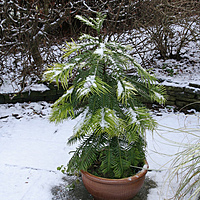Wollemi Pine
There has been much excitement at the Foale household as we are now proud owners of a Wollemi Pine. Peter bought me a lovely little specimen for Christmas, with bright green fern type leaves larger and flatter than a yew. If you don't know the story of this remarkable tree, it was around up to 200 million years ago and was thought extinct. Then, in 1994, a park ranger called David Noble was exploring the Wollemi National Park in Australia and stumbled across a small grove of them growing in a remote canyon. What struck him particularly was the trees bark, which looks like bubbling chocolate.
To cut a long story short, it was eventually identified and is now being produced in large numbers as an insurance policy against any disaster. They are expensive to buy, but everyone who has one can take part in a conservation effort; each Wollemi Pine sold returns a royalty to conserve the pine and other threatened species. And don't go looking for it if you visit Australia, the location of the trees are a closely guarded secret to protect them from collectors, vandals and diseases. Fewer than 100 trees have been found in the wild. You can, however, see more mature specimens now in many botanical gardens in this country and abroad. The blurb that comes with our tree claims that it is easy to grow and not fussy about where it is planted. It can be grown in a pot in its early years, and even coppiced to make a multi stemmed tree, but I'm not sure I've got the nerve to slice the trunk off! It has lots of unusual features, for example during the colder months the Wollemi Pine becomes dormant and its growing buds develop a pink and white waxy coating. I think Wolly the Wollemi is going to give us endless years of fascination into our old age. If you want to know more there is a website: www.wollemipine.co.uk and a book: The Wollemi Pine by James Woodford.
If the damp and grey weather is getting you down, why not have a mooch round the seeds in the garden centre? Many can be sown directly into the ground from next month. Annuals such as poppies, Calendula (pot marigold) and Nigella (love in a mist) are lovely and really easy. Just sprinkle them on to some decent, raked soil, cover them lightly and water well. Keep them watered while they are small and thin them when they get going. Be ruthless, they like space to develop into healthy plants. Once you have them, they will probably seed themselves around each year. They may also cover up the leaves of spring bulbs that look messy as they are dying off. You can also sow some vegetable seeds now, I'll try and get my tomato seeds going on the windowsill early next month.
If you have had any little pots of hyacinths or daffodils to brighten up the house, you can plant them outside when they have finished flowering. Deadhead them and plant each bulb at least twice its own depth, don't remove the leaves as these will provide food as they are dying down for next years flower. If you pop them round perennials, they provide a bit of interest early in the year, then disappear obligingly when the perennials come into their own.
Let's hope 2008 is a good gardening year for us, warm sunny days, gentle rain at night and a huge invasion of ladybirds and frogs to keep the nasties at bay. We can dream!
